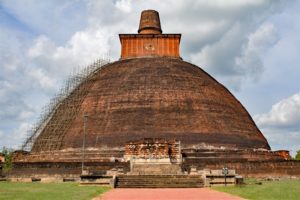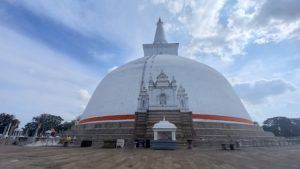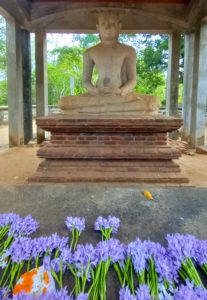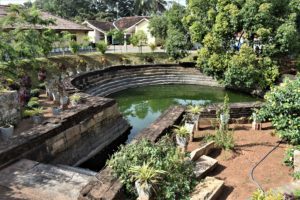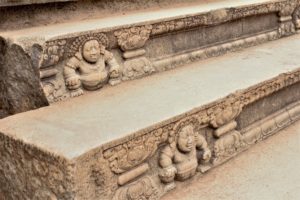We visited the ancient city of Anuradhapura, said to be the greatest of Sri Lanka’s ancient cities, on a day trip from our hotel in Trincomalee.
The huge complex of ruins has four main zones, so a car and guide are essential. As day time temperatures in February were 30 degrees plus, we set off on the 2-hour journey at 11.30am, which allowed us to juggle the heat, and allow plenty of time at the complex.
Because so many of Anuradhapura’s sights are still considered sacred, we had to dress modestly with shoulders and knees covered and hats removed. As shoes also have to be removed, socks were advised for the hot and rocky ground. We were also told about temple etiquette, which meant not having your photograph taken in front of Buddha to avoid having your back to him.
We started at the Jetavanarama Museum, where cameras had to be put away. An attendant walked in front of us and switched the lights on and off, as we were the only visitors wandering around the three galleries. These displayed: stone artefacts found in the monastery complex; jewellery and relics, with beads and bangles which wouldn’t look out of place today; and local and foreign pottery. It was simple, well laid out, had much needed air conditioning and probably more importantly, free and clean washrooms.
We then visited three stupors:
Jetavanarama Stupor – was made from bricks which had been super compressed and strengthened by elephants walking on them. Restoration work was being undertaken and scaffolding was evident in parts. Apart from a small group of school girls, once again, we were the only visitors, although a guy on a motor bike tried tempting us with gems as we got back into the car.
Thuparama Stupor – said to be the oldest visible stupor in the world, was brilliant white.
Ruvanvelisaya Stupor – again this was white, but more memorable with a red ribbon round it and 344 elephant reliefs around the outside.
Having walked around each of these substantial stupors in barefoot, our feet were suffering, and my partner dipped out of seeing the Mahavihara Alms House where its stone ‘canoe-shaped trough’, at 19m long was large enough for 5,000 alms bowls, and the Sri Maha Bodhi. Security was tight here with separate male and female airport like screening where an officious lady searched my bag, wiped me down with a wand, asked where I was from and who I was with. I must have stood out as the Sri Lankan pilgrims wore white. Having passed the test, we wandered around the large tree and saw the gold scaffolding holding it up in places.
At this stage an ice cream was required for revival purposes before visiting yet another stupor (Abhayagiri, the second highest), the twin ponds known as Kuttam Pokuna, a Buddha statue with wonderful offerings of bright blue hyacinths, Kaparamula with another stone trough, and Ethfeth Pokuna or Elephant Pond.
One of my favourites was the Ratnaprasada Jewel Palace where we could see three features in one place: guardstone, balustrade and moonstone with dwarfs carved on the steps. Another Moonstone also had jovial dwarfs, and these are the two that are famed for being exceptionally artistic.
Our final site was Isurumuniya Vihara. This was a new temple built into the rock with a viewing platform, but by now we were too tired to walk up as it was cracking on for 5pm and we were flagging. However, we went into a small museum with a few artefacts but with a carving of note (no photographs allowed).
Having arrived at 1.30, it was 5.30pm by the time we left absolutely exhausted, and on arrival back at the hotel, headed into the shower, quickly followed a large restorative G&T.
If you really want to do justice to Anuradhapura, I’d definitely recommend staying the night at one of the nearby hotels (and wearing socks).
